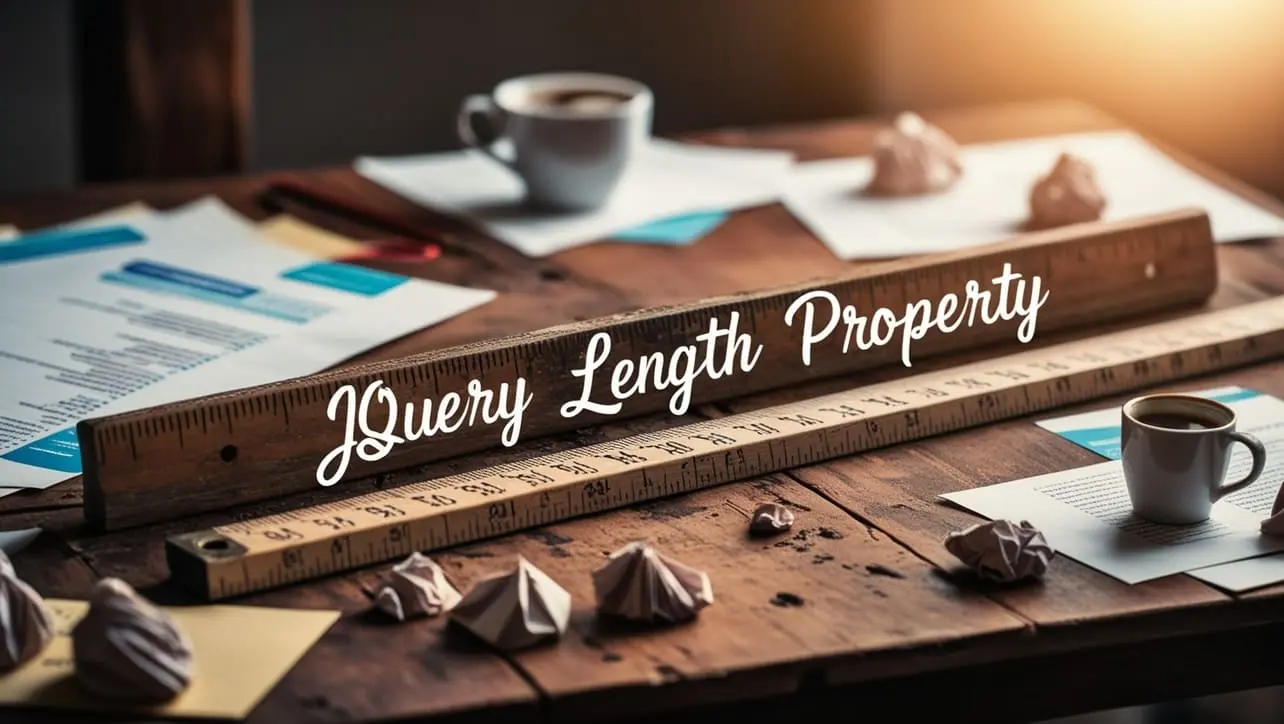
jQuery Topics
- jQuery Introduction
- jQuery Callbacks
- jQuery deferred
- jQuery selectors
- jQuery Ajax Events
- jQuery Ajax Methods
- jQuery Keyboard Events
- jQuery Keyboard Methods
- jQuery Form Events
- jQuery Form Methods
- jQuery Mouse Events
- jQuery Mouse Methods
- jQuery Event Properties
- jQuery Event Methods
- jQuery HTML
- jQuery CSS
- jQuery Fading
- jQuery Traversing
- jQuery Utilities
- jQuery Properties
jQuery .length Property

Photo Credit to CodeToFun
🙋 Introduction
jQuery is a powerful JavaScript library that makes web development simpler and more efficient. One of the many useful properties jQuery offers is the .length property. This property allows you to quickly determine the number of elements in a jQuery object. Understanding and utilizing the .length property can significantly enhance your ability to manage and manipulate HTML elements on your web pages.
In this guide, we'll explore the usage of the jQuery .length property with clear examples to help you grasp its full potential.
🧠 Understanding .length Property
The .length property in jQuery returns the number of elements in the jQuery object. This is particularly useful when you need to know how many elements match a specific selector or when performing operations on a collection of elements.
💡 Syntax
The syntax for the .length property is straightforward:
$(selector).lengthHere, $(selector) is the jQuery object, and .length returns the number of elements in that object.
📝 Example
Counting Elements:
You can use the
.lengthproperty to count the number of elements that match a specific selector. For instance, if you want to count the number of paragraphs (<p>) in your document:index.htmlCopied<p>First paragraph</p> <p>Second paragraph</p> <p>Third paragraph</p>example.jsCopiedvar numberOfParagraphs = $("p").length; console.log("Number of paragraphs: " + numberOfParagraphs);This will log Number of paragraphs: 3 to the console.
Conditional Statements:
The
.lengthproperty is often used in conditional statements to execute code based on the number of elements. For example, if you want to check if there are any checkboxes checked:index.htmlCopied<input type="checkbox" id="checkbox1" checked> <input type="checkbox" id="checkbox2"> <input type="checkbox" id="checkbox3" checked>example.jsCopiedif ($("input:checked").length > 0) { console.log("There are checked checkboxes."); } else { console.log("No checkboxes are checked."); }This will log There are checked checkboxes. to the console.
Looping Through Elements:
Although .each() is commonly used to loop through elements,
.lengthcan also be useful to control loop iterations. Here's an example of looping through a set of list items:index.htmlCopied<ul> <li>Item 1</li> <li>Item 2</li> <li>Item 3</li> </ul>example.jsCopiedvar listItems = $("ul li"); for (var i = 0; i < listItems.length; i++) { console.log(listItems[i].innerText); }This will log each list item's text to the console.
Checking if Elements Exist:
Sometimes, you need to check if any elements match a particular selector before performing an operation. Using the
.lengthproperty, you can easily do this:example.jsCopiedif ($(".someClass").length) { console.log("Elements with the class 'someClass' exist."); } else { console.log("No elements with the class 'someClass' found."); }Optimizing Performance:
Using the
.lengthproperty can help optimize performance by avoiding unnecessary DOM manipulations or event bindings when there are no matching elements:example.jsCopiedvar elements = $(".dynamicElement"); if (elements.length) { elements.on("click", function() { // Handle click event }); }
🎉 Conclusion
The jQuery .length property is a simple yet powerful tool for managing and manipulating collections of HTML elements. Whether you're counting elements, using conditional logic, or optimizing performance, the .length property provides an efficient way to work with jQuery objects.
By mastering its usage, you can write more effective and streamlined jQuery code, enhancing the interactivity and responsiveness of your web pages.
👨💻 Join our Community:
Author

For over eight years, I worked as a full-stack web developer. Now, I have chosen my profession as a full-time blogger at codetofun.com.
Buy me a coffee to make codetofun.com free for everyone.
Buy me a Coffee












If you have any doubts regarding this article (jQuery .length Property), please comment here. I will help you immediately.